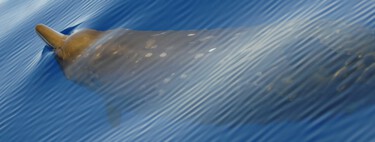Cinema is an art, and a very powerful one at that. At the end of the last century, two films starring marine giants were released that were very powerful in terms of having preconceived ideas about them. On the one hand, ‘Jaws’ showed us the most ferocious side of sharks. On the other, ‘Free Willy’ showed us the most adorable side of orcas. But orcas are known in Spanish by the nickname ‘killer whales’ (later adapted more accurately to ‘killer orcas’) for a reason.
As adorable as Willy is in his film, orcas are one of the most fearsome predators in the oceans. Not only do they hunt whales (hence their erroneous nickname) and have fun attacking ships off the Spanish coast, but they have been attacking sharks in such a violent way for years that they are managing to change the routines of these great marine predators.
The shark scarersOrcas are cetaceans and have observed They are present in almost all the world’s oceans and seas. They do not have a clear predator, but they feed on a wide variety of animals, both warm-blooded and cold-blooded. They hunt in packs and their speed, power and powerful jaw make them a lethal hunter.
This voracity is causing sharks to move to other areas of the oceans with one simple goal: to survive. In a recent study published In Frontiers, researchers have detailed that, between 2022 and 2023, they have recorded three cases of orcas hunting sharks in Cabo Pulmo National Park, in the Gulf of California in Mexican waters. They had recorded some attacks previously, but never within the park boundaries.
They are hunting themThe three attacks had mixed results. In the first, researchers say that as soon as the shark noticed the orcas’ presence, it swam out to deep water and escaped the attack. In the second, three orcas carried out a coordinated attack on a bull shark using a technique called “tail slapping.”


Orcas patrolling the area. Several have been identified as being involved in the various attacks
Basically, it consists of giving strong blows with the tail to destabilize the prey and to be able to sink the jaw. In the third case, a drone recorded four orcas eating a few bull sharks. In the study they state that they are observing a “clear absence of sharks that coincides with the presence of orcas in the park.” In fact, groups of a hundred sharks have been observed in the southern area of the park, near a reef. This is an area inaccessible to orcas, which indicates that they are seeking refuge.
Nothing new. In the study they comment that their results “suggest that orcas could be in the process of creating an ‘ecological landscape of fear’ for sharks.” The fact is that this is not something new or exclusive to these Mexican coasts. A year ago we reported that, thousands of kilometers from the Gulf of California, sightings of great white sharks had fallen sharply. Some people blamed this on overfishing that was killing the shark’s food or, directly, on a sudden interest in shark meat.
Several theories were put forward, one of them being that the saying “there is always a bigger fish” had indeed come true. Or at least, a more voracious one. The researchers considered that the disappearance of the sharks was related to the recent appearance of a pair of orcas that, according to their suspicions, had wiped out half a dozen sharks, causing the others to flee. Exactly the same as what happened in Mexico.


The moment of one of the attacks on a bull shark. The difference in size is noticeable
More sightings. Scientists have already pointed out that the killer whales were frightening the sharks and that they were not their first choice because white sharks are not usually thought of as prey, but, at least for killer whales, they are. Also, returning to the Gulf of California, the new study states that cases of killer whales feeding on elasmobranchs have been documented over the last 50 years, but that voracity may have increased.
What is clear is that it is now easier to study these types of cases thanks to the accessibility of drones and “citizen scientists.” It is something similar to what happens with NASA programs that seek to have untrained people, thanks to tools at their disposal, contribute to science. In this case, swimmers and tourists, thanks to their cameras and mobile phones, can easily record this type of behavior and share it so that researchers can draw their own conclusions.
Negative for the parkIn fact, two of the three cases in the Gulf of Mexico were filmed by visitors to Cabo Pulmo National Park. The problem is that sharks were one of the park’s attractions. Fishing activities were banned in 1995, which led to a surge in marine biodiversity, with large populations of fish and sharks flocking to the region. Bull sharks are one of the park’s attractions and can be seen at various diving sites, but if they leave, tourists may lose interest in the area.
The study says the effects of the displacement of the sharks would be dramatic, as visitors typically stay an average of four days in the park and spend an average of $694 per person. The researchers plan to conduct continuous aerial monitoring with drones and further collaboration with the local public to determine the long-term effects of the presence of orcas in the region. And also, what consequence it may have on the food chain if the sharks disappear from the area.
Images | Frontiers, Rennett Stowe from USA, Jeff Kubina from Columbia
In Xataka: Half a century ago, the Canary Islands created an artificial beach to attract tourism. Without knowing it, they set up a sanctuary for angel sharks














Add Comment